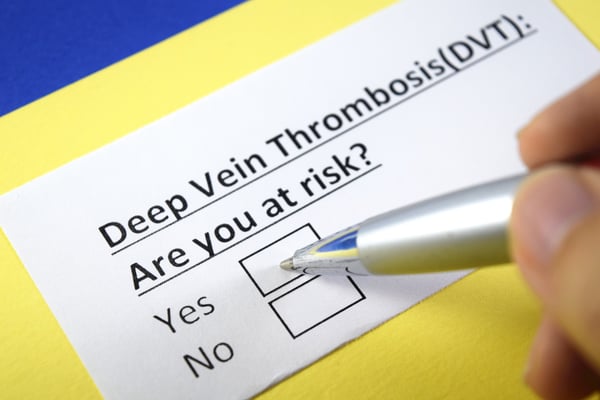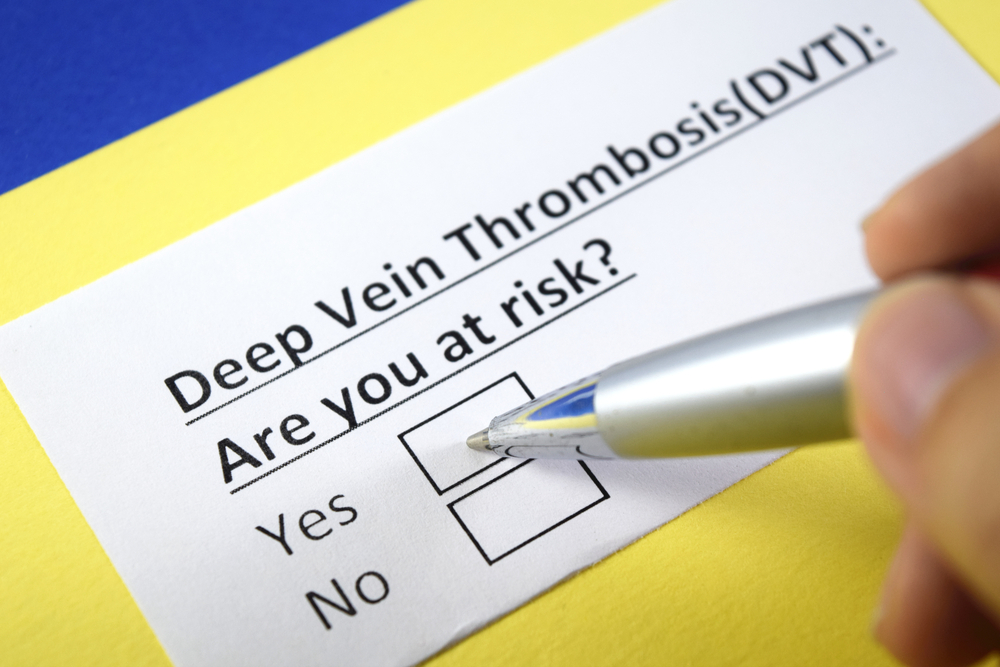Deep Vein Thrombosis: What is it and Should I be Worried?

Deep vein thrombosis (DVT) occurs when a blood clot, also known as a thrombus, develops within the so-called deep veins of your leg. They are called deep veins because they are not close to the skin and are next to the muscles and bones of your legs. It can sometimes be difficult to diagnose a DVT because it can be a mild partial version that may not produce symptoms. When symptoms do appear, the most likely are swelling and pain in the affected leg. The most feared consequence of a DVT occurs when the blood clot travels (an embolism) to the lungs where it can cause a fatal pulmonary embolism. Because of this risk, healthcare providers take the symptoms of a DVT seriously, and you should as well.
What Causes DVT?
Inactivity is the leading cause of DVT and can be due to travel, bed rest with a prolonged illness, or immobility after surgery. The common element to all of these is that without walking and moving your legs, blood flow slows down and begins to clot. Because of this, the hospital staff is especially vigilant about preventing DVT after surgery or trauma by assisting patients with regular walks or using leg pumps to aid circulation.
DVT Can Have Deadly Consequences
It’s important to take this condition seriously because ignoring it could be deadly. The vast majority of DVTs do not cause any life-threatening conditions, but some do. If a blood clot that has formed in your leg vein breaks free, it could travel from the blood in your legs and end up in your lungs. This can cause a condition called pulmonary embolism (PE). It means that the clot is blocking proper blood flow from the heart and can result in sudden death. This is a common cause of death for people in the hospital or who are ill and bedridden.
How Do I Know if I Have DVT?
Swelling and leg pain is usually the first and most obvious signs of DVT. Other symptoms include:
- A sensation of warmth in the affected leg
- The onset of leg pain or cramping in the calf or thigh when you try to walk
- Swelling in the affected leg when compared with the normal one
- Rarely, a tense, very painful, and swollen leg either from the groin down or just the calf
- Usually, a DVT is in one leg, rarely both legs
- Leg discoloration ranging from blue to purple or red
The critical test to make the diagnosis is a DVT ultrasound which is widely available at most large clinics and hospitals. Contacting your healthcare provider to order a DVT ultrasound is important if you suspect DVT.
What is a superficial thrombus and is it dangerous?
Also called superficial thrombophlebitis, this is a blood clot (a thrombus) that forms in the veins under the skin rather than the deeper veins near the muscles and bones. Because these veins are next to the skin where all the skin nerves are when a clot forms it is usually very painful and visible. The primary symptoms are pain, a red streak over the vein, a hard lump where the vein has clotted, pain with walking, swelling, and warm skin over the clotted vein. Thrombophlebitis is not a dangerous condition but it can be very painful and last several weeks. The most important thing is to make sure a DVT is not also present with a DVT ultrasound, since these sometimes go together.
How do I know if I have a pulmonary embolism (PE)?
You will need to seek immediate medical attention if you suspect that you have a PE. The most important test for a suspected PE is a CT scan which can be obtained at large medical clinics or hospitals. The symptoms most associated with this urgent health condition come on quickly and can include:
- Shortness of breath not related to exertion
- Low oxygen level (if you have an oxygen monitor)
- Coughing up blood
- Chest pain that gets worse when you cough or take a deep breath
- Dizzy or lightheaded feeling
- Fainting
- Rapid pulse rate
- Rapid respiratory rate
- A feeling of anxiety, restlessness, or panic due to low oxygen
Causes and Prevention of DVT:
Any factor that increases the tendency of your blood to clot can lead to DVT. Besides inactivity, other common causes include:
- Age 60 or older
- Being overweight or obese
- Certain types of cancer
- Family history of DVT or PE
- Genetic blood clotting disorder
- Heart failure
- Inflammatory bowel disease
- Oral contraceptive pills especially when smoking
- Pregnancy
- Inactivity due to surgery, trauma or illness
- Vein injury
While you can’t control every risk factor of DVT such as age or genetic predisposition, it’s important to reduce or eliminate the risk factors you can control. For example, lose weight if necessary, stop smoking, and learn your family history of DVT or genetic clotting disorders. Movement and walking regularly throughout the day is the most effective way to lower your risk of developing DVT.
With inactivity, a leading cause of DVT, be sure to avoid sitting still for too long whenever possible. There isn’t a magic cutoff, but the longer you are inactive the greater the risk. Even while on an airplane, you can stretch your legs and move your feet if you can’t get up and walk around. When you’re driving, stop every one to two hours to stretch and walk at least a little. If you’re on bedrest for any reason, work with your healthcare provider to be up and moving as soon as possible, or talk to them about getting an external leg circulation pump.


